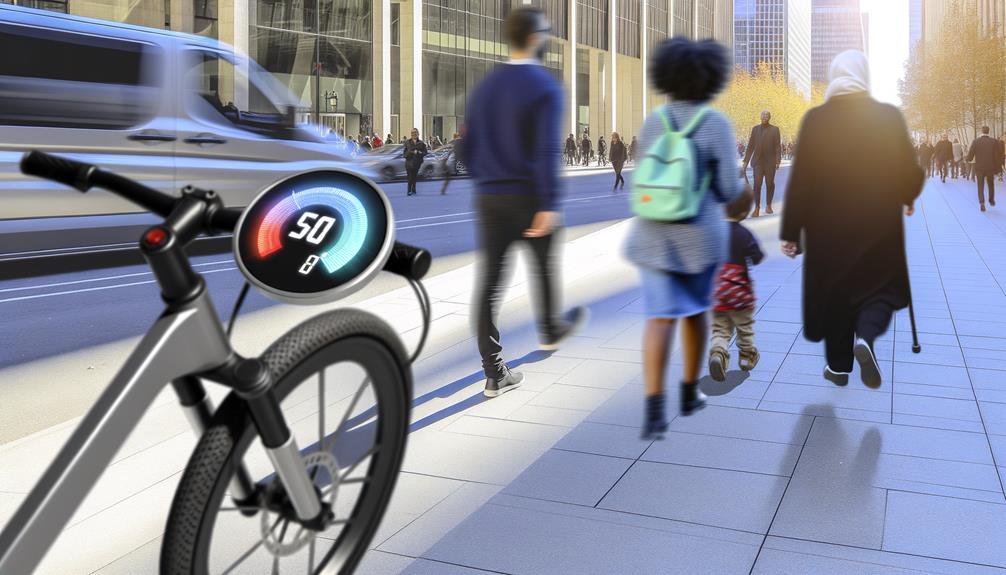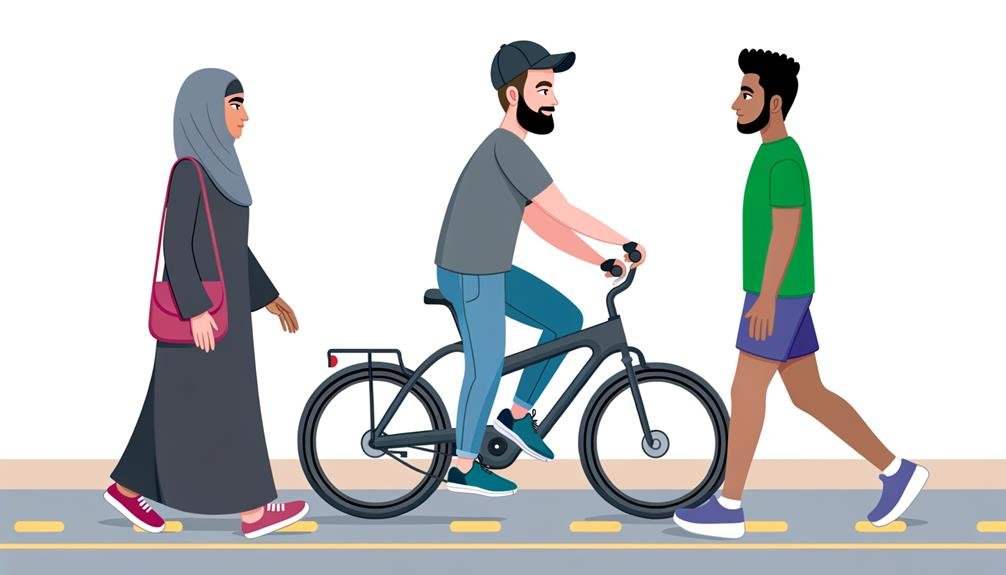Charles Miller is a veteran bike enthusiast with over 12 years of experience dealing with bikes as a mechanic. Despite immense love and expertise for...
Just as we were cruising down the high street on our new electric bikes, we found ourselves asking the question, can we ride these on the pavement?
It's a debate that's been sparked by the rise in popularity of electric bikes and the ambiguity in laws surrounding their usage. Now, we're not here to create a frenzy, but rather to shed light on this pertinent issue.
After all, understanding the rules can save us from potential penalties and ensure harmony between pedestrians and riders.
So, are you ready to navigate this labyrinth of regulations and opinions with us?
- Key Takeaways
- Understanding Electric Bike Laws
- Regional Differences in E-Bike Rules
- Safety Concerns of Riding on Pavements
- E-Bike Speed and Pavement Use
- Public Opinion on E-Bikes and Pavements
- The Impact on Pedestrians
- How to Ride E-Bikes Respectfully
- E-Bike Etiquette on Shared Paths
- Legal Consequences of Pavement Riding
- Advocating for Clearer E-Bike Laws
- Frequently Asked Questions
- Conclusion
Key Takeaways
- Electric bikes in Texas are classified into three categories with different speed limits and motor powers.
- Riding electric bikes on pavements poses safety hazards to pedestrians and can lead to accidents.
- Different countries have varying regulations regarding the use of electric bikes on pavements.
- Public opinion on allowing electric bikes on pavements is diverse, with some advocating for alternative transportation and others expressing concerns about pedestrian safety and the impact on traditional cyclists.
Understanding Electric Bike Laws
In order to safely and legally operate an electric bike in Texas, it's crucial to understand the specific laws that classify these bikes into three categories: Class 1, Class 2, and Class 3, each with their own motor and speed limitations. Understanding electric bike laws isn't just about compliance, but also about promoting a safe and positive e-bike culture in our state.
In Texas, we're lucky that licenses or registration aren't needed to ride an electric bike. However, it's important to be aware that age restrictions and helmet laws do exist and need to be adhered to. In terms of where you can ride, the rules and regulations are clear: roadways, bike paths, and trails are fair game, but the bike on the sidewalk is a no-go.
Each class of electric bike has different guidelines for riding on streets and trails. This ensures both our safety and the safety of others sharing these spaces. As riders and sellers, we share a responsibility to be aware of and respect these laws. This not only helps us avoid any legal troubles but also fosters a sense of belonging and community among electric bike enthusiasts.
Regional Differences in E-Bike Rules
As we shift our focus to the regional differences in e-bike rules, it's important to note the significant variation in regulations across Europe, North America, and Asia.
From lax policies in some areas to rigorous laws in others, the landscape of e-bike legislation is as diverse as the regions themselves.
We'll be examining the specific regulations in each of these areas, highlighting their unique approaches and implications for e-bike usage on pavement.
E-Bike Regulations in Europe
Navigating the labyrinth of e-bike regulations across Europe can be a challenge due to regional differences in rules. When you ride an e-bike, it's crucial to know the local laws. Riding an electric bike on the pavement, for instance, may be allowed in some regions but not in others. Similarly, power restrictions, speed limits, and age requirements can vary.
Let's look at a comparison of four different countries:
| Country | E-Bike Regulations |
|---|---|
| Germany | Restricted to roads/cycling lanes, speed up to 25 km/h |
| France | Allowed on pavements, speed up to 25 km/h |
| Spain | Restricted to roads, speed up to 45 km/h |
| Italy | Allowed on pavements, no speed limit |
Understanding these e-bike regulations in Europe can help maximize your use of eBikes and ensure a safe, legal ride.
North American E-Bike Laws
While we've explored the various e-bike regulations across European countries, it's worth noting that North American laws also hold regional differences, particularly focusing on the state of Texas. The laws governing e-bikes in this area are worth understanding to ensure you're riding your electric bike on the pavement within the law.
- Texas classifies electric bikes into three categories based on their motor and speed capabilities.
- No licenses or registrations are required, but age restrictions and helmet laws apply to certain classes.
- E-bikes are allowed on roadways, bike paths, and trails unless indicated otherwise, but not on sidewalks.
- There's proposed legislation to create a new e-bike class with distinct safety features and a 20 mph speed limit.
Staying updated with the North American e-bike laws, especially those in Texas, is crucial.
Asian E-Bike Legislation
Diving into the complexities of Asian e-bike legislation, it's clear that rules vary widely across different countries, with some treating electric bikes as motor vehicles and others as traditional bicycles. This diversity impacts how people can ride their electric bikes safely and legally.
For example, in some countries, there are specific guidelines on maximum motor power and speed limits, and age restrictions for e-bike riders. Some countries even require licensing and registration for electric bikes.
It's crucial for us to research and understand these regional differences to ensure we're part of a responsible e-bike community. Adherence to Asian e-bike legislation not only enhances safety but also fosters a sense of belonging among e-bike enthusiasts.
Safety Concerns of Riding on Pavements
Understanding the potential safety hazards of riding electric bikes on pavements is crucial, as these vehicles are typically not permitted on sidewalks due to the risk they pose to pedestrians. These safety concerns of riding on pavements are a significant issue that needs to be addressed with utmost seriousness.
While electric bikes are allowed on the roadways, they can still pose a threat to rider safety and others around. Here are some potential dangers:
- High speed: Electric bikes can exceed the typical cycling speed, causing accidents if a rider isn't experienced or careful.
- Pedestrian safety: Pedestrians aren't expecting fast-moving bikes on pavements, raising the risk of collisions.
- Limited space: Pavements aren't designed for bike riding, leading to potential crashes or falls.
- Legal implications: Laws generally prohibit electric bikes on pavements, and ignoring them can lead to penalties.
We must remember that the laws are in place to promote safety. Adhering to these regulations not only ensures rider safety but also contributes to a harmonious co-existence with pedestrians and other road users. Let's respect these rules and create a positive e-bike culture.
E-Bike Speed and Pavement Use

Navigating the intricacies of e-bike speed and pavement use, particularly in Texas, requires an understanding of the state's classification system and the accompanying rules and regulations. Texas classifies e-bikes into three categories: Class 1, Class 2, and Class 3. These classes are defined by their motor power and speed limits. It's important to note that e-bikes must comply with these specifications to ensure a safe and legal ride class.
Here's a quick guide:
| Ride Class | Speed Limit | Motor Power |
|---|---|---|
| Class 1 | 20 mph | Pedal-assist |
| Class 2 | 20 mph | Throttle-assist |
| Class 3 | 28 mph | Pedal-assist |
However, e-bike speed and pavement use aren't the only considerations. Age restrictions apply to Class 3 e-bikes, and helmet use is required for riders under 18. Riding an e-bike on a bike path or trail is allowed, but e-bikes aren't permitted on sidewalks. As we navigate this new era of mobility, it's crucial we adhere to these rules for our safety and the well-being of our community.
Public Opinion on E-Bikes and Pavements
While adherence to speed limits and regulations is essential, it's equally important to consider the varying perspectives on e-bikes and their use on pavements. Public opinion on e-bikes and pavements is diverse, influenced by local laws, personal experiences, and individual perceptions of safety.
Some believe e-bikes should be permitted to ride on pavements. They argue this could:
- Promote alternative transportation
- Reduce traffic congestion
- Encourage the use of e-bikes over cars
- Increase the safety of e-bike users by separating them from road traffic
However, others have concerns. They worry that allowing e-bikes on pavements could jeopardize pedestrian safety and disrupt traditional cyclists. The design and speed capabilities of certain e-bike models also play a role in shaping public opinion.
It's clear that the concept of allowing e-bikes to ride an electric bike on the pavement stirs varied public opinion. The creation of dedicated bike lanes and awareness campaigns about e-bike etiquette could play a pivotal role in molding a more positive perception, ensuring everyone feels they belong on our city's paths.
The Impact on Pedestrians

The shift towards allowing electric bikes on pavements raises substantial concerns about pedestrian safety, particularly in states like Texas where e-bike laws are currently under review. As we delve into the impact on pedestrians, we must consider the potential hazards that could arise if we allow individuals to ride an electric bike on the pavement.
Pedestrians, comprised of children, the elderly, and those with disabilities, occupy pavements. These vulnerable groups could be at risk if e-bikes are allowed to share their space. Furthermore, electric bikes are typically faster than traditional bicycles, which could increase the risk of accidents.
Despite the requirement for e-bike riders to give way to pedestrians, compliance isn't guaranteed. E-bike riders mightn't always yield, leading to potential accidents.
Currently, e-bikes are prohibited on non-motorized trails in Texas. If the proposed legislation passes, e-bikes could be allowed on all trails unless specifically off-limits. This could exacerbate existing issues of pedestrian and cyclist conflict on shared trails.
How to Ride E-Bikes Respectfully
Understanding how to ride e-bikes respectfully involves not just adhering to local regulations, but also demonstrating mindfulness of our speed, prioritizing pedestrian safety, and educating both ourselves and others about these rules.
Riding bikes safely and within the guidelines set by local authority is key to ensuring a harmonious coexistence with pedestrians and other road users.
We can foster a community of respectful e-bike riders by following a few simple guidelines:
- Always follow local regulations: Stay informed about the specific laws in your area and adhere to them.
- Be mindful of your speed: It's important to respect speed limits, especially in shared spaces.
- Prioritize pedestrian safety: Always yield to pedestrians and alert them of your presence.
- Use designated bike lanes: If available, these lanes are designed for our safety and ease of travel.
E-Bike Etiquette on Shared Paths

Building on the principles of respectful e-bike riding, let's consider the specific etiquette required when navigating shared paths. When we ride an electric bike on such paths, we enter a shared space bustling with pedestrians and other cyclists. Therefore, it's paramount to yield to pedestrians, showing them the courtesy they deserve.
Keeping a moderate pace is vital. It's not just about our enjoyment of the ride; it's about ensuring the safety of everyone on the pavement. High speeds can create dangerous situations, so let's remember to keep it steady and under control.
Communication is key on shared paths. When overtaking pedestrians, a ring of our bell or a friendly verbal signal can avoid surprises and keep everyone comfortable.
Let's not forget about local regulations and posted signs. These rules aren't there to limit our fun, but to foster a harmonious environment for all path users. They guide our e-bike etiquette on shared paths, ensuring we contribute positively to the shared space.
Lastly, maintaining a safe distance when passing others is a sign of respect and care. Let's embrace these etiquettes and make our e-bike ride on the pavement an enjoyable experience for all.
Legal Consequences of Pavement Riding
We're about to explore the legal consequences of riding electric bikes on the pavement.
We'll consider traffic laws and penalties, safety implications, and how regulations differ globally.
It's crucial to understand these issues to ride responsibly and avoid legal repercussions.
Traffic Laws and Penalties
Amid the thrill and convenience of riding electric bikes, it's crucial to remember that in many places, traffic laws generally prohibit their use on pavements, leading to potential fines and penalties. If you're caught riding an electric bike on the pavement where it's not allowed, you might have to deal with legal consequences.
Here are a few things to consider:
- You may be asked to pay a fine if you're found riding on the pavement.
- You might be required to show proof that you're allowed to ride.
- In some areas, you may even need a license to ride an electric bike.
- Ignorance of the law is no excuse, so stay updated with local traffic laws and penalties.
Let's all stay safe and legal, folks!
Safety Implications
When it comes to riding electric bikes on pavements, it's our responsibility to understand the potential legal consequences, especially given that many states like Texas strictly prohibit such practices. As bike riders, we must be aware of the safety implications of pavement riding. Violating these regulations could lead to fines, citations, and other legal penalties.
We should familiarize ourselves with local laws before deciding to ride an electric bike on the pavement. Proposed legislation in Texas may soon change the landscape, but until then, we must adhere to current rules.
It's our duty to foster a positive e-bike culture, and that begins with understanding and respecting the law for safe, legal riding.
Regulatory Differences Globally
Navigating the global landscape of electric bike regulations, it's crucial to note that different countries have their own rules regarding pavement riding, with legal consequences varying widely. As we delve into these regulatory differences globally, we're met with a patchwork of laws and penalties.
Some regions, like certain European countries, allow electric bikes on pavements, but with speed restrictions.
In contrast, in the U.S., laws vary by state and city, with some completely prohibiting pavement riding.
Australia and New Zealand too have strict fines for riding electric bikes on pavements.
However, in Japan, electric bikes are treated as regular bicycles and can be ridden on pavements.
Being part of our community means staying informed and compliant to enjoy safe, legal e-bike rides.
Advocating for Clearer E-Bike Laws
Despite the existing e-bike laws in Texas, there's a pressing need for clearer regulations that address the use of different classes of electric bikes on pavements and trails. We're advocating for clearer e-bike laws that reflect the unique aspects of each class, ensuring safety for all users while granting riders the freedom to enjoy their e-bikes as they wish.
| Class of electric bikes | Allowed on Pavement? | Specific Regulations |
|---|---|---|
| Class 1 | Yes | Pedal-assist only, speed limit of 20 mph |
| Class 2 | Yes | Throttle-assisted, speed limit of 20 mph |
| Class 3 | No | Pedal-assist only, speed limit of 28 mph |
As we can see, bikes are classified based on their motor assistance type and speed. Yet, the question remains: "Can you ride an electric bike on the pavement?" And the answer varies depending on the class.
This emphasizes the importance of clear, comprehensive regulations that consider the type of e-bike and the conditions under which it is used. We believe in laws that promote safety, respect for all road users, and the joy of riding an e-bike.
Frequently Asked Questions
Can an Electric Bike Be Used on a Sidewalk?
We can't ride electric bikes on sidewalks in Texas due to pedestrian safety, eBike legislation, sidewalk etiquette, and accessibility concerns. It's important we respect these laws for our safety and that of others.
Can I Ride an Electric Bike on the Road?
Yes, we can ride an electric bike on the road. We must follow road safety measures, respect ebike speed limits, understand traffic regulations' impact, and acknowledge the importance of road etiquette.
Do Texas State Parks Allow Ebikes?
Yes, we can ride Class 1 and 2 ebikes in Texas state parks. However, the parks don't permit Class 3 bikes. We've to comply with Texas regulations and park restrictions, just like traditional cyclists.
Can You Ride an Electric Bicycle on the Sidewalk in Michigan?
We've investigated Michigan legislation and found that, due to safety concerns, it's generally prohibited to ride electric bikes on sidewalks. Local ordinances may vary, so it's always wise to check local rules first.
Conclusion
In the long run, it's crystal clear we must respect local laws when riding our e-bikes. It's not a walk in the park navigating through the mixed bag of regional rules and public opinion. Safety, etiquette, and speed all play a role.
Let's campaign for clearer e-bike laws, but until then, let's stick to designated lanes and paths. After all, better safe than sorry when it comes to sharing the road responsibly.

Charles Miller is a veteran bike enthusiast with over 12 years of experience dealing with bikes as a mechanic. Despite immense love and expertise for his Tacoma, he rides his Trek Ebike more. Anytime you meet him, you’ll either hear him talking about Bikes, or writing about all things bikes and cars on this blog.
More Posts


